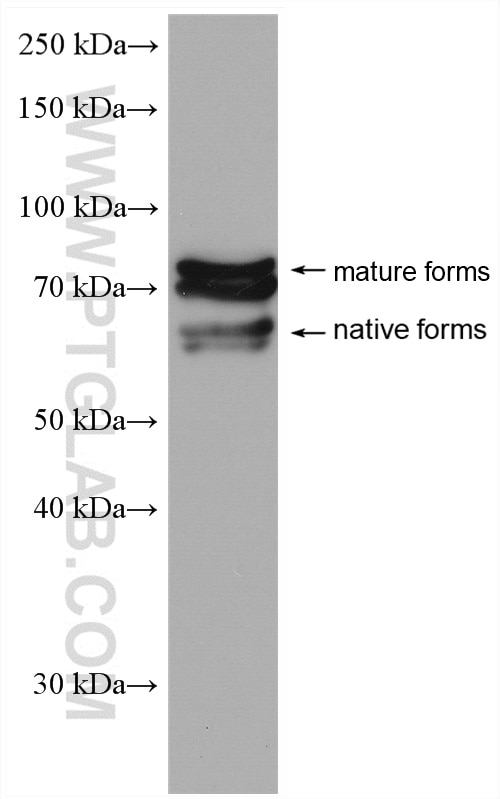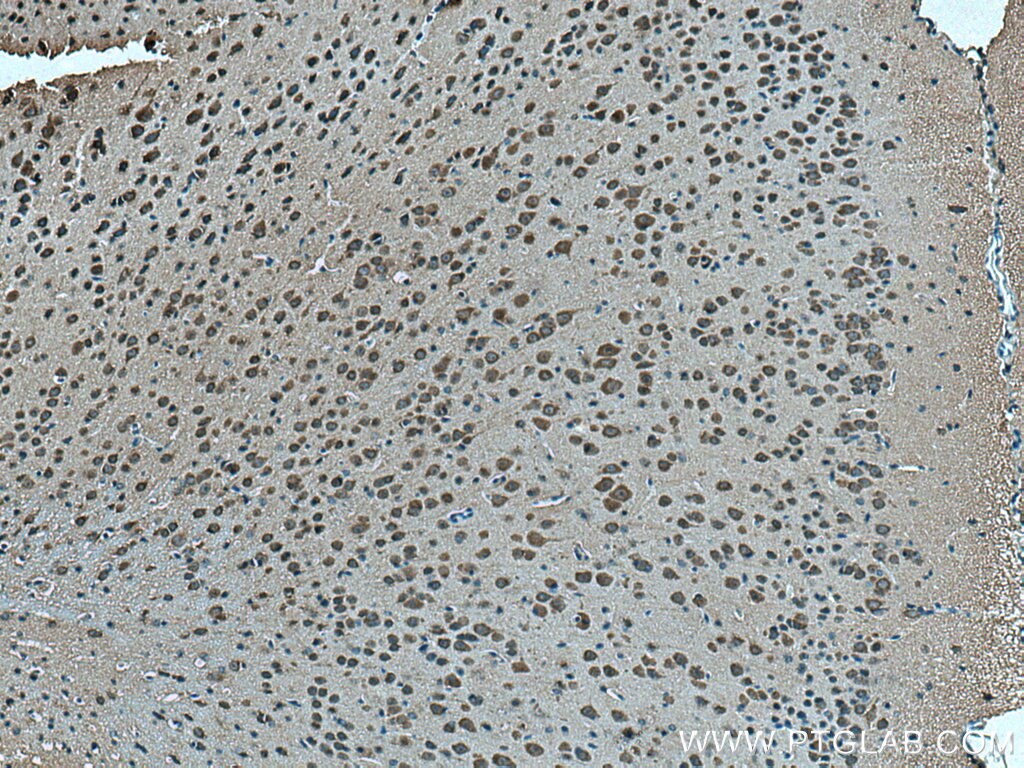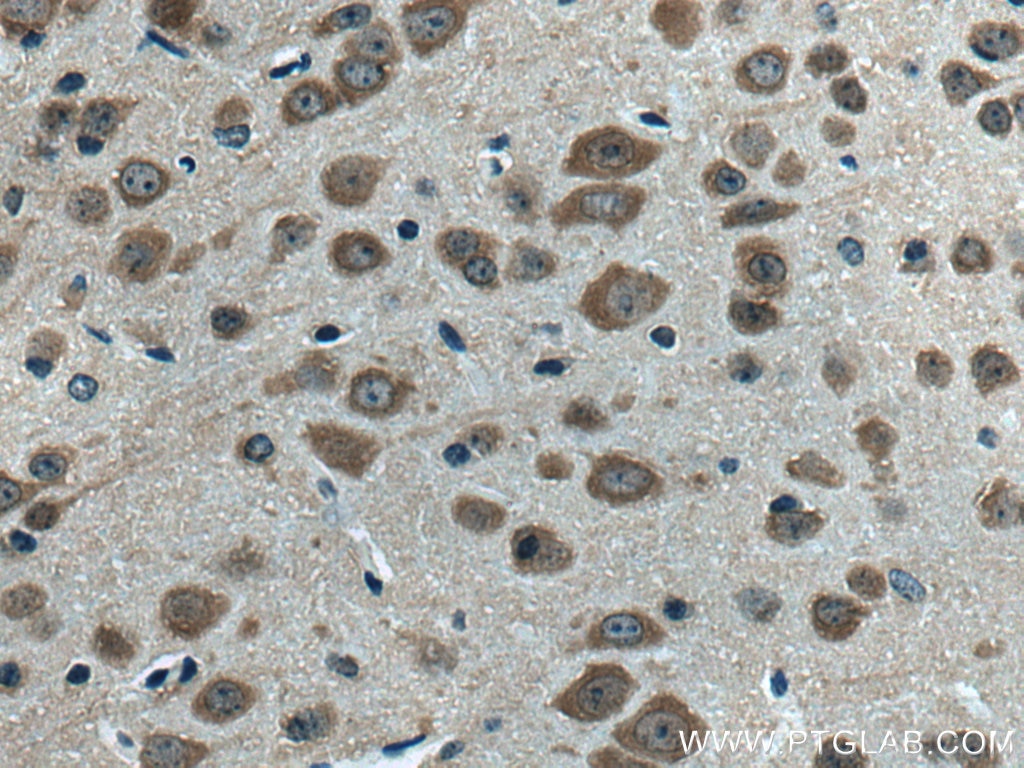Anticorps Polyclonal de lapin anti-OAT1
OAT1 Polyclonal Antibody for IHC, WB,ELISA
Hôte / Isotype
Lapin / IgG
Réactivité testée
Humain, souris et plus (1)
Applications
WB, IHC, IF, ELISA
Conjugaison
Non conjugué
N° de cat : 26574-1-AP
Synonymes
Galerie de données de validation
Applications testées
| Résultats positifs en WB | tissu cérébral de souris, |
| Résultats positifs en IHC | tissu cérébral de souris, il est suggéré de démasquer l'antigène avec un tampon de TE buffer pH 9.0; (*) À défaut, 'le démasquage de l'antigène peut être 'effectué avec un tampon citrate pH 6,0. |
Dilution recommandée
| Application | Dilution |
|---|---|
| Western Blot (WB) | WB : 1:500-1:2000 |
| Immunohistochimie (IHC) | IHC : 1:50-1:500 |
| It is recommended that this reagent should be titrated in each testing system to obtain optimal results. | |
| Sample-dependent, check data in validation data gallery | |
Applications publiées
| WB | See 13 publications below |
| IF | See 1 publications below |
Informations sur le produit
26574-1-AP cible OAT1 dans les applications de WB, IHC, IF, ELISA et montre une réactivité avec des échantillons Humain, souris
| Réactivité | Humain, souris |
| Réactivité citée | rat, Humain, souris |
| Hôte / Isotype | Lapin / IgG |
| Clonalité | Polyclonal |
| Type | Anticorps |
| Immunogène | OAT1 Protéine recombinante Ag24234 |
| Nom complet | solute carrier family 22 (organic anion transporter), member 6 |
| Masse moléculaire calculée | 62 kDa |
| Poids moléculaire observé | 60-65 and 70-80 kDa |
| Numéro d’acquisition GenBank | BC033682 |
| Symbole du gène | SLC22A6 |
| Identification du gène (NCBI) | 9356 |
| Conjugaison | Non conjugué |
| Forme | Liquide |
| Méthode de purification | Purification par affinité contre l'antigène |
| Tampon de stockage | PBS avec azoture de sodium à 0,02 % et glycérol à 50 % pH 7,3 |
| Conditions de stockage | Stocker à -20°C. Stable pendant un an après l'expédition. L'aliquotage n'est pas nécessaire pour le stockage à -20oC Les 20ul contiennent 0,1% de BSA. |
Informations générales
OAT1, also named as SLC22A6, has two GXXXG motifs in its transmembrane which is associated with protein processing and oligomerization of other proteins. OAT1 is involved in the renal elimination of endogenous and exogenous organic anions. It has been reported that OAT1 plays a key role in clearing endogenous metabolites, toxins and drugs from blood. OAT1 has some isoforms and the calculated MW ranges from 55 kDa to 62 kDa. 26574-1-AP antibody detects the 60-65 kDa (native forms) and 70-80 kDa (mature forms) protein in SDS-PAGE. (PMID: 21340049, 23389457, 23196129)
Protocole
| Product Specific Protocols | |
|---|---|
| WB protocol for OAT1 antibody 26574-1-AP | Download protocol |
| IHC protocol for OAT1 antibody 26574-1-AP | Download protocol |
| Standard Protocols | |
|---|---|
| Click here to view our Standard Protocols |
Publications
| Species | Application | Title |
|---|---|---|
Phytomedicine Amelioration effects of α-viniferin on hyperuricemia and hyperuricemia-induced kidney injury in mice | ||
J Ethnopharmacol Fuling-Zexie formula attenuates hyperuricemia-induced nephropathy and inhibits JAK2/STAT3 signaling and NLRP3 inflammasome activation in mice | ||
J Ethnopharmacol Simiao San alleviates hyperuricemia and kidney inflammation by inhibiting NLRP3 inflammasome and JAK2/STAT3 signaling in hyperuricemia mice | ||
Am J Physiol Renal Physiol SGLT2 inhibitor dapagliflozin protects the kidney in a murine model of Balkan nephropathy | ||
Tissue Eng Part A Inhibition of TGF-β improves primary renal tubule cell differentiation in long-term culture | ||
Eur J Pharmacol Berberrubine attenuates potassium oxonate- and hypoxanthine-induced hyperuricemia by regulating urate transporters and JAK2/STAT3 signaling pathway |




